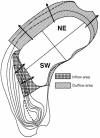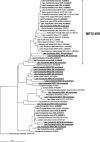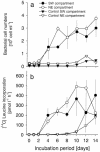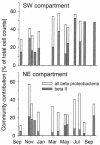Members of a readily enriched beta-proteobacterial clade are common in surface waters of a humic lake
- PMID: 14602613
- PMCID: PMC262289
- DOI: 10.1128/AEM.69.11.6550-6559.2003
Members of a readily enriched beta-proteobacterial clade are common in surface waters of a humic lake
Abstract
Humic lakes are systems often characterized by irregular high input of dissolved organic carbon (DOC) from the catchment. We hypothesized that specific bacterial groups which rapidly respond to changes in DOC availability might form large populations in such habitats. Seasonal changes of microbial community composition were studied in two compartments of an artificially divided bog lake with contrasting DOC inputs. These changes were compared to community shifts induced during short-term enrichment experiments. Inocula from the two compartments were diluted 1:10 into water from the more DOC-rich compartment, and inorganic nutrients were added to avoid microbial N and P limitation. The dilutions were incubated for a period of 2 weeks. The microbial assemblages were analyzed by cloning and sequencing of 16S rRNA genes and by fluorescence in situ hybridization with specific oligonucleotide probes. beta-Proteobacteria from a cosmopolitan freshwater lineage related to Polynucleobacter necessarius (beta II) were rapidly enriched in all treatments. In contrast, members of the class Actinobacteria did not respond to the enhanced availability of DOC by an immediate increase in growth rate, and their relative abundances declined during the incubations. In lake water members of the beta II clade seasonally constituted up to 50% of all microbes in the water column. Bacteria from this lineage annually formed a significantly higher fraction of the microbial community in the lake compartment with a higher allochthonous influx than in the other compartment. Actinobacteria represented a second numerically important bacterioplankton group, but without clear differences between the compartments. We suggest that the pelagic microbial community of the studied system harbors two major components with fundamentally different growth strategies.
Figures







References
-
- Babenzien, D., and C. Babenzien. 1990. Microbial activities in a naturally acidotrophic lake. Arch. Hydrobiol. Suppl. 34:175-181.
-
- Bittl, T., and H.-D. Babenzien. 1996. Microbial activities in an artificially divided acidic lake. Arch. Hydrobiol. Adv. Limnol. 48:113-121.
-
- Brosius, J., T. J. Dull, D. D. Sleeter, and H. F. Noller. 1981. Gene organization and primary structure of a ribosomal RNA operon from Escherichia coli. J. Mol. Biol. 148:107-127. - PubMed
Publication types
MeSH terms
Substances
Associated data
- Actions
- Actions
- Actions
- Actions
- Actions
- Actions
- Actions
- Actions
- Actions
- Actions
- Actions
- Actions
- Actions
- Actions
- Actions
- Actions
- Actions
- Actions
- Actions
- Actions
- Actions
- Actions
- Actions
- Actions
- Actions
- Actions
- Actions
- Actions
- Actions
- Actions
- Actions
- Actions
- Actions
- Actions
- Actions
- Actions
- Actions
- Actions
- Actions
- Actions
- Actions
- Actions
- Actions
- Actions
- Actions
- Actions
- Actions
- Actions
- Actions
- Actions
- Actions
- Actions
- Actions
- Actions
- Actions
- Actions
- Actions
- Actions
- Actions
- Actions
LinkOut - more resources
Full Text Sources
Molecular Biology Databases

